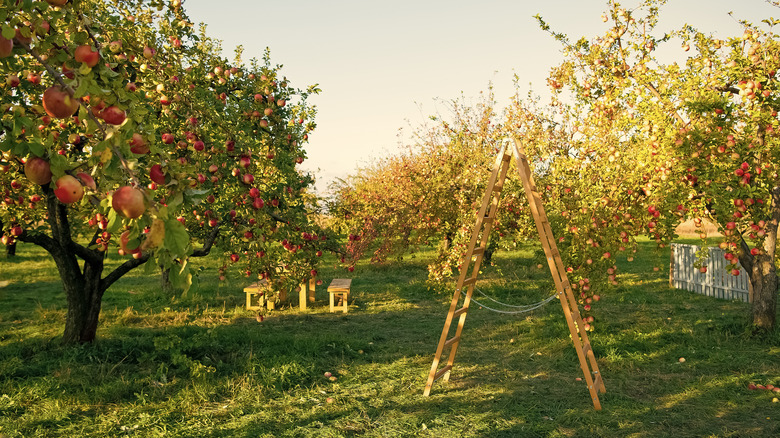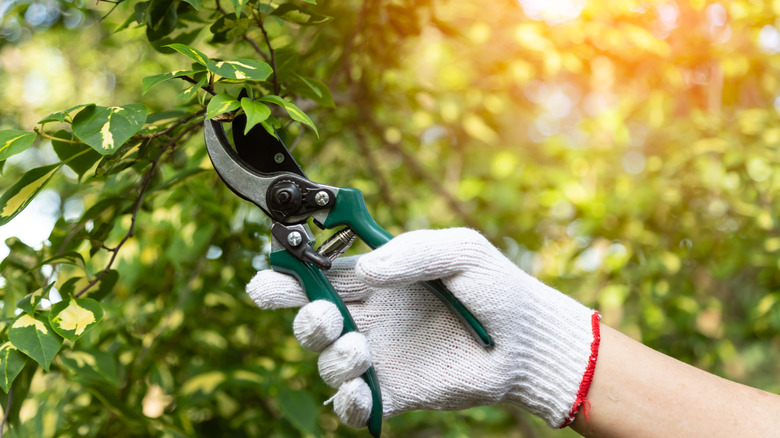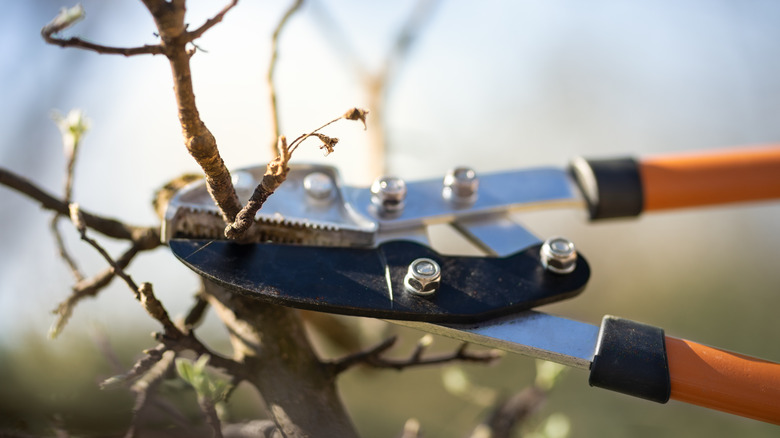How To Prune Apple Trees
Whether you have a small yard, a large garden, or even a farm, fruit trees can be a bountiful addition to your property. From adding value to your home to decreasing your carbon footprint and feeding your family, fruit trees offer many benefits (via Summer Winds Nursery). However, when it comes to fruit trees, there's a bit of a learning curve; there are many factors to consider including pollination, climate, and pest control. In terms of malus domestica, known as the domesticated apple tree, pruning can be a big help.
A centuries old practice, pruning involves trimming back excess branches, as well as removing any dead, diseased, or damaged wood from your trees. Along with removing any parts of your tree that may affect its health, pruning, according to The Spruce, allows for air to move freely through the branches and for sunlight to reach the interior and lower portions of your tree's canopy. Pruning also helps with tree growth, development, and potential fruit production.
Pruning can be done on standard and dwarf apple trees and is most effective in the last few weeks of winter. Pruning during this time of the year allows you to evaluate your tree's structure while it is dormant and the act of pruning is less stressful for your apple tree. Late winter pruning also provides you with the opportunity to remove any limbs that have been damaged by ice, wind, and snow.
How to prune a fruit tree
As for the tools that you'll need for pruning, HGTV recommends using hand pruners, loppers, a pruning saw, and a tape measure. You should also utilize safety gear such as leather gloves and safety glasses when pruning and err on the side of caution, especially when handling larger branches. Before you begin cutting branches off of your apple tree, make sure you know which types of branches you should be removing, how to cut the branches properly, and how much you should be removing overall.
If you're pruning a young apple tree, make sure you have a shape in mind. For beginners, Lawn Starter suggests pruning your tree into a natural shape, a single or multiple leader shape, or an espaliered shape. But be careful when selecting a shape for your apple tree as each one has its own advantages and disadvantages. Some of them don't require as much pruning but produce smaller apples, while other shapes are better fit for tighter spaces and mimic vines.
How to prune your apple tree
Generally, you should remove about 25% of your apple tree's active growth during each pruning session. Look for branches that are too close to the central trunk, any crowded or crossed twigs, and any competing branches. They should be cut at their base, with any branches over an inch in diameter removed at the branch collar, which is where the branches meet the trunk. When it comes to deciding which branches to remove, a good rule of thumb is to keep the branches with the most buds. They will likely be more productive over time and won't hinder your apple tree's health.
You should also be heading back your apple tree, according to Lawn Starter, which will keep it from growing vertically. Routinely heading back your tree will encourage the branches to grow thicker, shorter, and increase the growth of the lower portions of your tree's canopy. Home Depot additionally recommends removing any water sprouts that grow straight up or down from the main branches, as well as suckers, which are fast growing shoots that grow from the roots and trunk of the tree.
Once you have removed the excess growth and diseased wood from your apple tree, make sure to pick up any downed branches that could reintroduce diseases and pests to your tree. You should also make sure to clean your tools to remove any extra sawdust and sap that could cause your gardening tools to rust.


